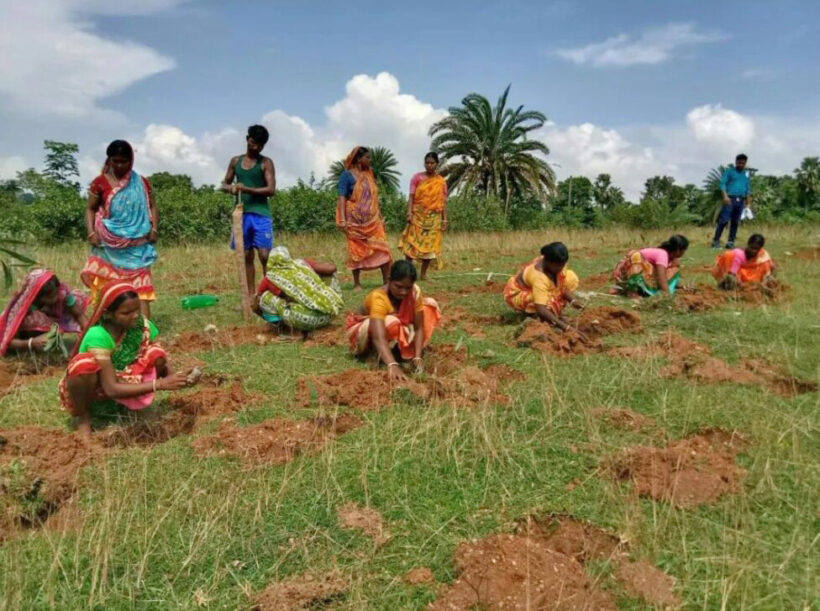In Jhargram, a remote village in the Indian state of West Bengal, a group of farmers sit together in one of the large fields around them. Here they must discuss, deliberate and decide on the marketing strategy they will use to sell their crop in the markets of the region.
Two years ago, the situation in this remote village was completely different. Farmers were troubled by the sudden inflation and rising prices of seeds, fertilisers and seedlings. They were also preoccupied with climate change and the damage from the disruption of weather patterns in the recent monsoons, unseasonal rains and extreme heat waves.
The state of West Bengal is located in northeast India along the Bay of Bengal. It was in this Indian state that the British East India Company began doing business before going on to rule almost all of South Asia.
West Bengal is primarily an agricultural region. Despite covering only 2.7% of India’s territory, it is home to 8% of India’s more than 1.3 billion people. There are 7.1 million farming families in the state, of which 96 % are subsistence farmers.
The average land area is only 0.77 hectares. The state has a wide range of natural resources and agro-climatic conditions that allow the production of a wide variety of crops.
However, in recent years, farmers in this area have been particularly affected. According to recent research conducted to determine the intensity of the agricultural crisis in the region, agricultural yields for farmers were low.
The main reasons for the low agricultural yields were a faulty marketing system, low agricultural prices, fluctuating commodity prices and crop failure due to disease, floods and heavy rains.
Jayanta Sahu, a farmer from Jhargram, where some 250 families live, in Murshidabad municipality, recalls how the drastic price hike of seeds and seedlings put family farmers like him in dire straits.
“We belong to a village, which is far away from the city. It takes hours by bus to get to the markets. Hardly a bus passes through this place,” Sahu told IPS during the days IPS spent in the village.
That was the reason, he added, “why we used to depend mostly on middlemen to supply us with seeds, fertiliser and other items needed for farming. They used to take their commission from the supplies, and we were left with extremely expensive material”.
The farmer details that several problems have affected local agriculture in the past, such as loss of agricultural land, shortage of local seeds and seedlings, irrigation and lack of agricultural infrastructure, manure, fertilisers and biocides.
But above all, Sahu said, the plummeting income from farming made them “miserable” in more ways than one.
“We couldn’t even cover our family’s basic expenses with the meagre income from farming. Inflation and climate change put a strain on our finances. We were really helpless in the face of such a tumultuous situation,” said Sahu.
Another farmer from the same village, Mongal Dash, recalls that he was on the verge of saying goodbye to farming for good and taking up work as a labourer in cities in the region.
He summarised that “we were fighting on multiple fronts: the low yields of our crops, the high cost of fertilisers and seeds, and climate change”.
“The middlemen who supplied us with seeds raised the basic cost four or five times. We had no choice but to buy from them. The degraded quality of these seeds resulted in low yields and ultimately low incomes,” Dash told IPS.
Faced with an insurmountable situation, the farmers in the village decided to get together and discuss what to do with their work and their lives.
It was perish or thrive.
After hours of deliberation, they identified the main problems affecting them and how they should address them as a matter of priority.
One of the main obstacles was the involvement of middlemen or commission agents in the purchase of seeds. Another was the long distance to the city, which made it difficult to acquire seeds and fertilisers for their crops.
At that time, they discussed a strategy to produce their own seeds and seedlings, which they could produce themselves and thus cultivate safely and obtain profitable yields.
The village producers identified six experienced and veteran farmers who were commissioned to produce their indigenous seeds and seedlings. They were given training on seed preservation, seedbed preparation, composting and pest control.
In addition, a plot of land of about four hectares was identified and seedbeds of cabbage, cauliflower, chilli and other vegetables were prepared, along with about 9,000 seedlings. The farmers decided that no chemical fertilisers or pesticides would be used on the seedlings and seedbeds, and that everything would be grown organically.
The seedlings were distributed at low cost to farmers in the village according to their needs.
Now, more than a year later, the collective effort made by these farmers, who would otherwise be in crisis, is beginning to yield the desired results.
“We are no longer dependent on the foreign market for seeds. We do not use chemical fertilisers or import degraded plants from abroad. Our village is becoming self-sufficient in this regard, and we are very proud of it,” says another local farmer, Shyam Bisui.
Farmers, who otherwise had to spend about a third of their annual income on buying inorganic seeds and chemical fertilisers, now save most of their money because they also use organic fertilisers.
The seeds are prepared in the village and the women are actively involved in the process.
“Yields are gradually increasing, and so are our hopes of living well. We are sure that our earnest efforts will bring us prosperity, and we will never perish,” said the farmer from Jhargram in Kandi sub-division, part of Murshidabad municipality.










